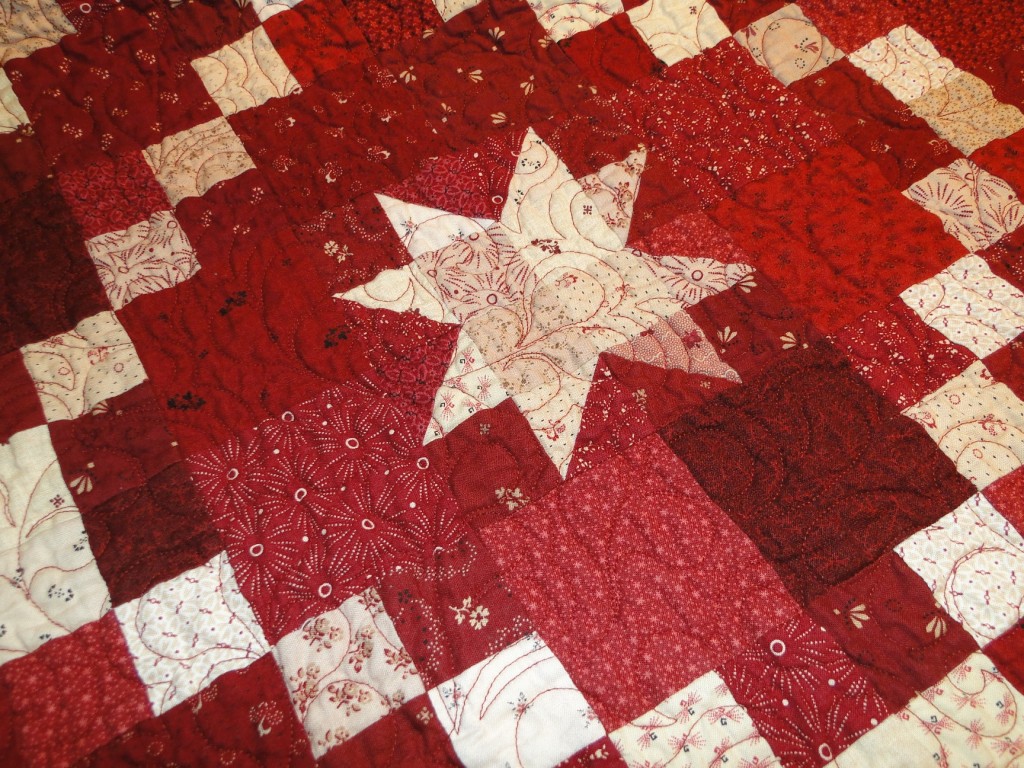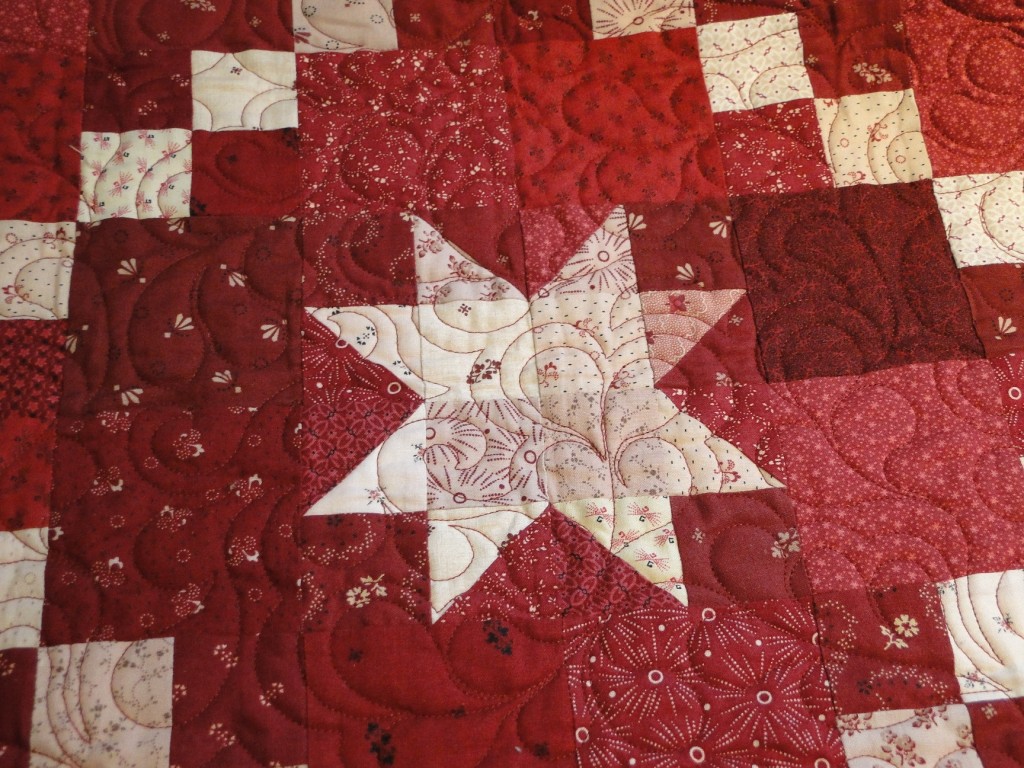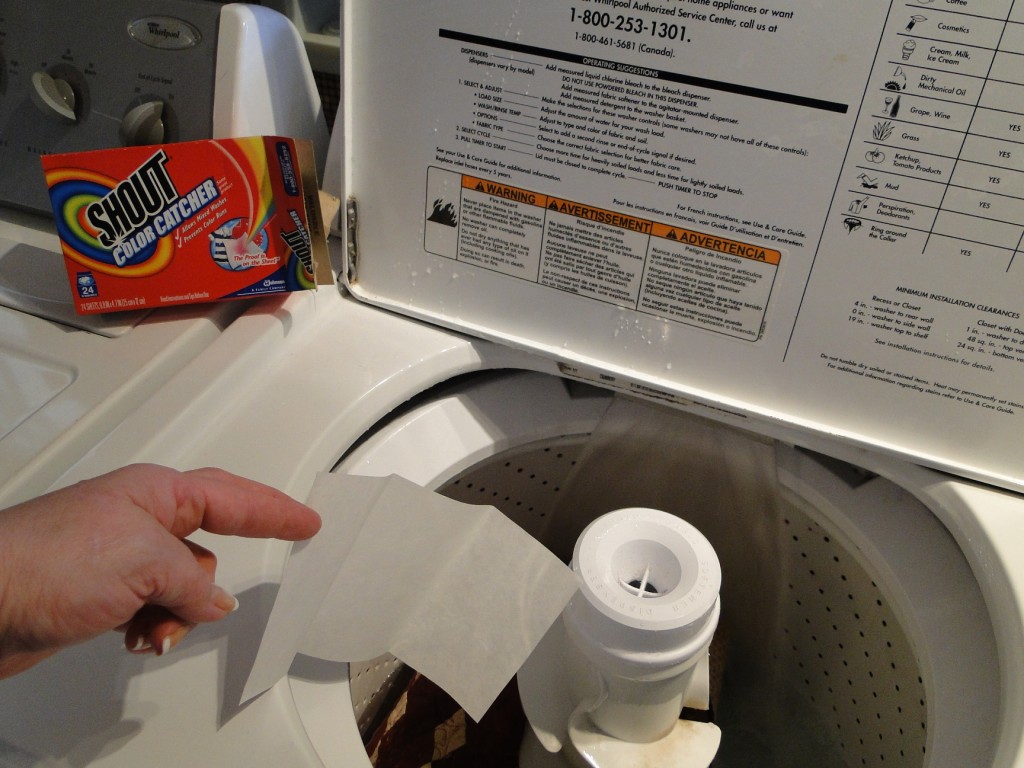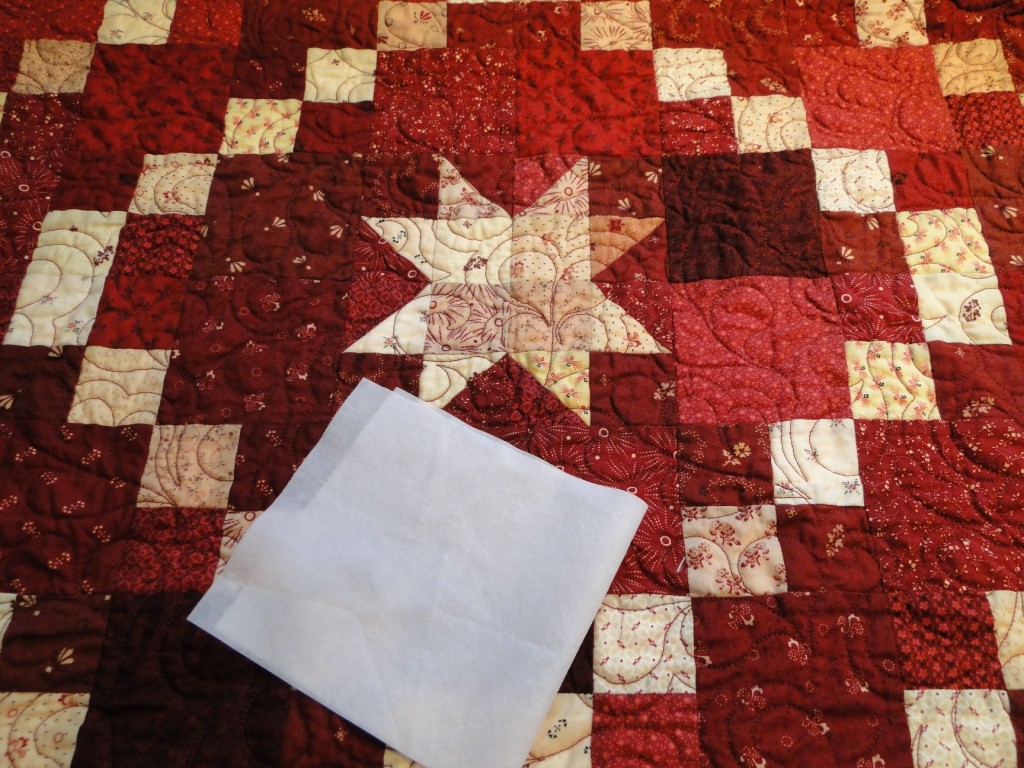Every once in a while the question comes up, and now seems to be a good time to address it again, especially with so many rich, vibrant colors found in today’s fabric collections. Concerns about dye loss or possible color migration can increase when you’re blending deep reds with light ground coordinates, similar to those found in found in A PRAIRIE GATHERING by Pam Buda.
We chatted with Pam about her preferences and best practices for pre-treating quilt fabrics. She routinely tells her students & quilting friends:
“I never wash my fabric. I actually add a lot of sizing to my yardage to make it stiffer before I cut anything out, so washing would remove the sizing already in the fabric from the manufacturing process, and I add more.” (Pam firmly believe that sizing and adding the extra body/stiffness aids tremendously with everything from cutting, piecing, and pressing, making your piecing more accurate!) “That said, when my reds are wet with the sizing (and I really saturate the fabric with sizing!) I have not had any issues with the red, or any other color, running. In all the years I have been quilting with quilt shop quality fabrics, I have never once had an issue with dye running,” she explains.
The decision to pre-wash fabric or not is largely a personal preference that could depend in part on what you’re making with the fabric. A quilt that will be used and washed often should probably be made with pre-washed fabrics, while a decorative wall hanging can be made with non-washed fabric.
Thankfully, there are so many fabrications and production methods available to quilters today, including batiks and hand-dyed fabrics! So, like Pam, we always advise taking the time to do a wash test whenever you are in doubt. Marcus’ standard for overall quality speaks for itself over the years, including colorfastness, as Pam can attest to since she began designing with us. There are products like Retayne and Dye Catcher if you’re concerned about running. Check out Pam’s impressive wash-test results – no dyes were released in the wash, as shown by the completely clean color catcher sheet after laundering. As you probably know, deep reds like these are notorious for at least some color loss in laundering.
What are your tricks and tips for pre-treating your quilting fabrics? Do you, or don’t you? Like Pam, I’m not inclined to pre-wash. But I might for a baby quilt, to remove any lingering chemicals or finishes on the fabric before it comes into contact with the baby (of course, I don’t sew many baby quilts…). So again, the circumstances will help to dictate your pre-washing decisions.
Thanks for the photos, Pam! —— lisa s





I have only ever had troubles with fabrics that were NOT quilting cottons. Or, in one instance, only one white fabric picked up the red from one other fabric when no other white in the quilt did the same thing. It was maddening. The white was the problem, not the red in that instance. I still do not pre-wash quilting cottons. I even have pre-washed quilting cottons in my stash and they go into the quilt right along side everything else. I like the sizing fabric has when it comes off the bolt and I use that to help me with cutting and piecing.
what about batiks? Should those be prewashed?
Hi Bev – For me it always goes back to the end use. For quilts, pillows & other decorative uses, I don’t even think about pre-washing. For clothing, table settings & other things tha twill be laundered regularly, I give prewashing more thought. If ever in doubt, pre-wash! — lisa
i have been quilting for more years than most have , probably 40+. For many of those years I chose not to prewash my fabric. But lately after making machine embroidered applique, I have noticed the fabric is shrinking and the embriodery is not, thus causing a noticeable pucker around the applique. I also have noticed my very old fabrics were not pleasant to smell, particularly when ironing. So I set about a daunting task of prewashing all of my fabric that is not on a bolt. I have ironed and re folded almost 3/4 of my stash after washing and drying on a gental cycle. My sister and I have compared piecing non pre washed and prewash fabric, and we have both come to the conclusion that pre washed is easier to piece, easier to quilt, and smells much better. The dyes seem to turn sour, or rancid after sitting on a shelf, after a few years.
I do starch or use fabric finish when I embroider, or applique, I think my test results have personally made me very glad to pre wash all of my fabric.
Probably over 75 loads and another 25 to go.
JMHO
I never, ever prewash because, like Pam, I like the stiffness the sizing right off the bolt which gives me for accuracy in cutting and piecing. I use a lot of reds and deep colors in my quilts and have never had a problems with dye running and bleeding. I do use a Color Catcher and from time to time they actually pick up some color. I might also note that I use a phosphorant-free soap and when I wash my quilts I use the cold water wash and rinse settings. With quality fabrics – especially those from Marcus (love ‘ya!) I really don’t think you can go wrong.
Cheers!
What phosphorous-free detergent do you use? How can you tell if a detergent is phosphorous-free? I have used Dreft on a quilt, but I’m not crazy about the fragrance in the detergent. I would rather use All free or Tide free, or some other product free from fragrance. Any ideas? Thanks.
I use Charlie’s Soap. Been using it for years. We buy it in a 5 gallon tub and it lasts for a long time – and I wash at least once a day. Charlie’s Soap if very committed to the environment. You check them out at http://www.charliesoap.com
About pre-washing…So, reds are not pre-washed. The quilt is made and then washed with sizing? What is sizing?
Thanks,
Mary
Hi Mary – The quilt is not washed with sizing. Sizing similar to starch, it’s a spray you use when pressing the fabrics before you cut them, to give them some added body or stability. This helps you to cut the fabric more accurately and reduces any distortion of bias seams, etc while you are handling the cut pieces. You would find it in the store aisle with spray starch & other ironing aids.
I have had severe bleeding problems with reds on ecology cloth with a wool batt when the quilt was still on my quilting frame. In one case I used water to remove blue pen marks, in the other case I was using water to remove holes from stitches that were removed. In the first case the remainder of the quilt was fine when I soaked it in cold water to remove the remaining blue marks. I then washed it in Synthrapol on very hot to remove any stray dye, it worked to remove about 98% of the bleed. I re-blocked the quilt several months later and had a huge bleed from fabric used to make the label. It was the same fabric used for binding. I am wondering if the chemicals in the printable fabric also used in the label cause the original binding fabric to bleed. It bled through to the front and was very hard to remove. A second synthrapol treatment, followed by oxyclean, made it presentable but not perfect. All the hot water washed started the batt to felt. So, still not sure what caused the original bleeds. Needless to say, I prewash reds and am very cautious in washing them!